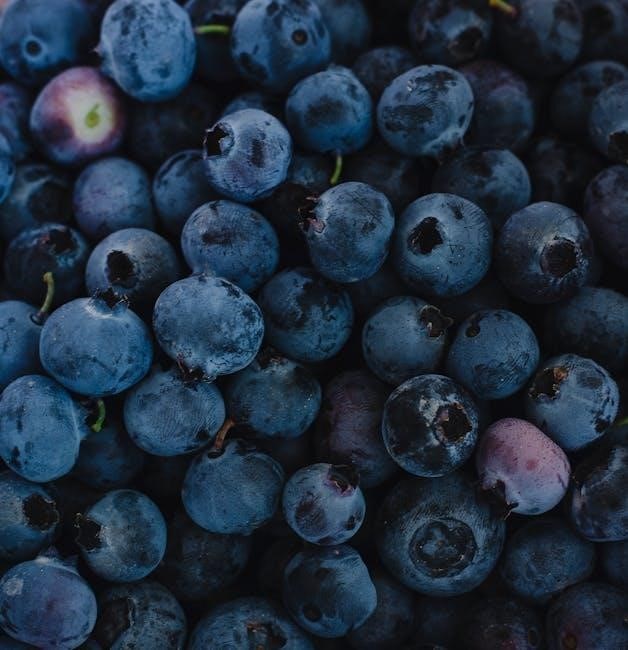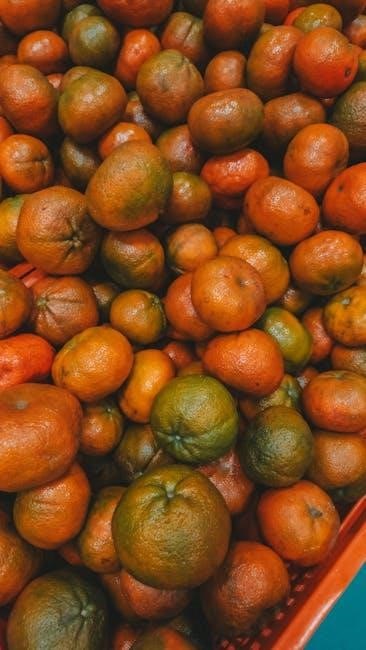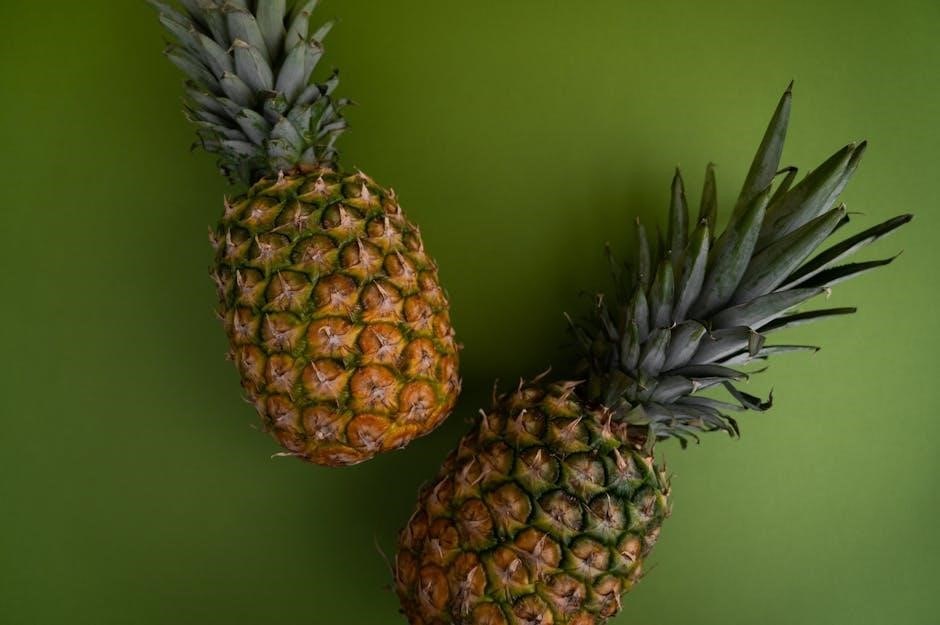Whole foods are unprocessed‚ nutrient-dense foods in their natural state‚ offering essential vitamins‚ minerals‚ and fiber. This guide provides a comprehensive list‚ including a downloadable PDF‚ to help you transition to a healthier diet focused on whole foods.
1.1 What Are Whole Foods?
Whole foods are unprocessed‚ nutrient-dense foods in their natural state‚ such as vegetables‚ fruits‚ meats‚ whole grains‚ and legumes. They are free from additives‚ preservatives‚ and artificial ingredients‚ ensuring maximum nutritional value. These foods provide essential vitamins‚ minerals‚ fiber‚ and phytonutrients‚ supporting overall health and well-being. A whole food list PDF offers a detailed guide to these foods‚ helping you identify and incorporate them into your diet for a healthier lifestyle.
1.2 Importance of Whole Foods in Modern Diets
Whole foods play a crucial role in modern diets by providing essential nutrients‚ fiber‚ and antioxidants. They help combat chronic diseases‚ improve digestion‚ and boost energy levels. With rising health concerns‚ whole foods are a natural solution to nutrient deficiencies and processed food dependency. Incorporating them into daily meals promotes long-term well-being and supports overall health. A whole food list PDF serves as a valuable resource for identifying and incorporating these foods into a balanced diet.

Health Benefits of Whole Foods
Whole foods offer numerous health benefits‚ including preventing chronic diseases‚ improving digestion‚ and boosting energy. They are rich in essential nutrients‚ vitamins‚ and fiber‚ promoting overall well-being.
2.1 Nutrient Density and Essential Vitamins
Whole foods are nutrient-dense‚ providing essential vitamins‚ minerals‚ and antioxidants. They include vitamins A‚ C‚ and E‚ along with minerals like calcium and iron. These nutrients support immune function‚ energy production‚ and overall health. Incorporating a variety of whole foods ensures optimal nutrient intake‚ reducing the risk of deficiencies and promoting long-term well-being.
2.2 Fiber Content and Digestive Health
Whole foods are rich in dietary fiber‚ which is crucial for digestive health. Fiber helps regulate bowel movements‚ prevent constipation‚ and support the growth of beneficial gut bacteria. A diet high in whole foods like fruits‚ vegetables‚ and whole grains promotes a healthy digestive system‚ reducing the risk of conditions such as irritable bowel syndrome and diverticulitis. Additionally‚ fiber aids in satiety and blood sugar regulation‚ contributing to overall well-being.
2.3 Antioxidants and Chronic Disease Prevention
Whole foods are abundant in antioxidants‚ which protect cells from oxidative stress and inflammation‚ key factors in chronic diseases like heart disease and cancer. Foods rich in antioxidants include berries‚ leafy greens‚ nuts‚ and seeds. These compounds help neutralize free radicals‚ reducing the risk of conditions such as Alzheimer’s and cardiovascular disorders. Incorporating antioxidant-rich whole foods into your diet supports long-term health and well-being by combating oxidative damage and promoting cellular health.
Categories of Whole Foods
Whole foods encompass a variety of natural‚ unprocessed food groups‚ including vegetables‚ fruits‚ proteins‚ whole grains‚ dairy‚ nuts‚ seeds‚ healthy oils‚ and legumes‚ each offering unique nutritional benefits.
3.1 Vegetables
Vegetables are a cornerstone of whole foods‚ offering vibrant colors and nutrient-rich benefits. From leafy greens like spinach and kale to root vegetables such as carrots and beets‚ they provide essential vitamins‚ minerals‚ and antioxidants. Cruciferous vegetables like broccoli and Brussels sprouts support detoxification‚ while bell peppers and cucumbers add hydration and fiber; Incorporate them raw‚ roasted‚ sautéed‚ or in soups for a balanced diet. A whole food list PDF often highlights these varieties‚ ensuring diverse and nourishing meal options.
3.2 Fruits
Fruits are a vibrant and essential part of whole foods‚ offering natural sweetness and a wealth of nutrients. From berries and citrus fruits to apples and bananas‚ they provide vitamins‚ minerals‚ and antioxidants that support immune function and overall health. A whole food list PDF often includes a variety of fruits‚ emphasizing their role in promoting energy and well-being. Incorporate seasonal and colorful options to maximize nutritional benefits and flavor in your diet.
3.3 Protein Sources (Meat‚ Fish‚ Eggs)
Whole food protein sources include grass-fed meats‚ wild-caught fish‚ and free-range eggs‚ offering essential amino acids and nutrients. These options are rich in iron‚ omega-3 fatty acids‚ and vitamins‚ supporting muscle growth and overall health. A whole food list PDF often highlights lean meats like chicken and turkey‚ fatty fish like salmon‚ and sustainable seafood choices‚ guiding you to make nutrient-dense selections for balanced meals.
3.4 Whole Grains
Whole grains‚ such as quinoa‚ brown rice‚ barley‚ oats‚ and bulgur‚ are rich in fiber‚ vitamins‚ and minerals. They provide sustained energy and support digestive health. A whole food list PDF often includes these grains‚ emphasizing their nutrient-dense profiles and versatility in recipes. Whole grains are a cornerstone of a balanced diet‚ offering antioxidants and nutrients that promote overall well-being and long-term health benefits.
3.5 Dairy Products
Dairy products like milk‚ yogurt‚ and cheese are included in whole food lists for their nutrient-rich profiles. They provide protein‚ calcium‚ and probiotics‚ supporting bone health and digestion. A whole food list PDF often recommends organic‚ grass-fed options to avoid additives. Dairy products are versatile‚ enhancing meals with natural flavors and textures while promoting overall well-being.
3.6 Nuts and Seeds
Nuts and seeds are rich in healthy fats‚ protein‚ and fiber‚ making them a valuable addition to whole food diets. A whole food list PDF often includes varieties like almonds‚ walnuts‚ chia seeds‚ and flaxseeds. These provide essential nutrients and support heart health. They are recommended in moderation due to their calorie density‚ offering a convenient snack and enhancing meal variety naturally.
3.7 Healthy Oils and Fats
Healthy oils and fats are vital for heart health and provide essential fatty acids. A whole food list PDF often includes options like olive oil‚ coconut oil‚ and avocado oil‚ which are rich in antioxidants and support overall wellness. These oils are ideal for cooking‚ dressings‚ and enhancing the flavor of whole food dishes without adding processed ingredients‚ making them a cornerstone of a balanced diet.
3.8 Legumes and Pulses
Legumes and pulses are rich in protein‚ fiber‚ and essential nutrients‚ making them a cornerstone of a whole food diet. A whole food list PDF often highlights options like lentils‚ chickpeas‚ black beans‚ and kidney beans. These versatile ingredients are perfect for soups‚ salads‚ and main dishes‚ offering sustained energy and supporting heart health. They are also naturally low in fat and high in antioxidants‚ making them a healthy addition to any meal plan focused on whole‚ unprocessed foods.

Meal Planning with Whole Foods
A whole food list PDF helps organize meals‚ ensuring balanced nutrition. Plan breakfast‚ lunch‚ and snacks with fresh produce‚ grains‚ and proteins for a healthy‚ sustainable diet.

4.1 Breakfast Ideas Using Whole Foods
Start your day with nutrient-dense whole food breakfasts. Try omelettes with spinach‚ mushrooms‚ and tomatoes‚ or overnight oats made with rolled oats and fresh berries. Incorporate chia pudding with almond milk and seeds for added fiber. Avocado toast on whole-grain bread or smoothies packed with greens‚ fruits‚ and nuts are excellent choices. Use a whole food list PDF to explore diverse recipes‚ ensuring your breakfast is balanced‚ delicious‚ and full of energy.
4.2 Lunch and Dinner Recipes
Whole foods shine in hearty‚ flavorful lunches and dinners. Try stuffed bell peppers with quinoa‚ vegetables‚ and lean meat‚ or grilled salmon with roasted sweet potatoes and broccoli. Salads like kale Caesar with homemade dressing or chickpea bowls are nutritious options. Incorporate soups made with legumes and fresh herbs‚ or stir-fries with mixed vegetables and brown rice. Use your whole food list PDF to explore diverse‚ balanced recipes that cater to various dietary preferences and preferences‚ ensuring satisfying meals every time.
4.3 Snacking Options
Snacking on whole foods keeps energy levels steady and cravings at bay. Reach for nuts like almonds or walnuts‚ fresh fruits like apples or berries‚ and veggie sticks with hummus. Seeds‚ trail mix‚ and homemade energy balls made with oats and nuts are also great choices. Avoid processed snacks and opt for nutrient-dense options that satisfy hunger without compromising your commitment to whole‚ unprocessed foods. Use your whole food list PDF to discover more quick‚ healthy snack ideas.

Grocery Shopping Tips
Plan your shopping with a whole food list PDF to ensure you select nutrient-dense‚ unprocessed items. Focus on fresh produce‚ lean proteins‚ and whole grains‚ avoiding packaged goods.
5.1 How to Identify Whole Foods
Whole foods are unprocessed‚ natural foods like fruits‚ vegetables‚ lean proteins‚ and whole grains. They are typically found in their raw form‚ free from additives and preservatives. Avoid packaged items with lengthy ingredient lists. Focus on foods that grow on trees‚ bushes‚ or in the ground‚ and opt for wild-caught or grass-fed options for meats and fish. Reading labels can help you identify whole foods‚ ensuring they align with your dietary goals and promote better health.
5.2 Reading Food Labels
Reading food labels is crucial to identify whole foods. Look for short ingredient lists with recognizable‚ natural components. Avoid products with added sugars‚ artificial flavors‚ or preservatives. Ensure labels highlight “100% whole grain” or “no added sugars.” Be wary of packaging that mimics whole foods but contains processed ingredients. Choose products with minimal processing and no hidden additives to align with your whole food diet goals and maintain optimal health.
5.3 Budget-Friendly Shopping Strategies
To shop affordably for whole foods‚ buy in bulk for items like grains‚ nuts‚ and seeds. Plan meals to reduce waste and save money. Use coupons or shop in season for fresh produce. Opt for store brands or generic labels‚ which often offer similar quality at lower costs. Consider shopping at local markets or farms for fresh‚ affordable whole foods. Prioritize whole food staples like beans‚ rice‚ and vegetables‚ which are budget-friendly and nutritious.

Avoiding Processed Foods
Processed foods often lack nutrients and contain harmful additives. Focus on whole foods like fruits‚ vegetables‚ and grains to avoid unhealthy preservatives and artificial ingredients.
6.1 Understanding Processed Foods
Processed foods are altered from their natural state through manufacturing‚ often adding preservatives‚ sugars‚ and unhealthy fats. They frequently lack essential nutrients‚ promoting weight gain and chronic diseases. Examples include packaged snacks‚ sugary beverages‚ and refined grains. These foods are typically high in calories but low in nutritional value‚ making them detrimental to health. Recognizing processed foods is crucial for maintaining a diet rich in whole‚ unprocessed ingredients that support overall well-being and longevity.
6.2 Hidden Sources of Processed Ingredients
Many seemingly healthy foods contain hidden processed ingredients‚ such as added sugars‚ preservatives‚ and unhealthy fats. Even items like granola bars‚ flavored yogurts‚ and whole-grain breads can harbor these additives. Reading labels carefully is essential to identify these sneaky components‚ ensuring your diet remains aligned with whole food principles. A whole food list PDF can help you recognize and avoid such products‚ promoting cleaner eating habits and better health outcomes by focusing on unprocessed‚ natural ingredients.
6.3 Alternatives to Common Processed Foods
Replace processed foods with whole food alternatives to enhance nutrition and reduce additives. Opt for homemade snacks like trail mix instead of chips‚ and choose whole grains over refined bread. Use natural sweeteners like honey or dates instead of sugary treats. Incorporate fresh vegetables and lean proteins for snacks. A whole food list PDF can guide you in selecting unprocessed options‚ helping you avoid preservatives and artificial flavors while improving overall dietary quality and health benefits.

Whole Foods and Special Diets
Whole foods seamlessly integrate into special diets like Whole30‚ Plant-Based‚ and Low-Carb plans. A whole food list PDF provides guidance on selecting nutrient-dense options tailored to these diets.
7.1 Whole30 Diet
The Whole30 diet focuses on eliminating processed foods‚ sugars‚ and grains for 30 days. It emphasizes whole foods like meats‚ vegetables‚ fruits‚ nuts‚ and seeds. A Whole30 food list PDF provides a clear guide to compliant foods‚ helping you avoid non-permitted items. This approach aims to improve digestion‚ reduce inflammation‚ and boost energy. By following the Whole30 food list‚ you can create balanced meals that align with the program’s principles and support overall health.

7.2 Plant-Based Diets
A plant-based diet focuses on whole‚ minimally processed foods like fruits‚ vegetables‚ legumes‚ and whole grains‚ minimizing animal products. A whole food list PDF can help guide your grocery shopping‚ ensuring you select nutrient-rich options. This diet is associated with reduced risks of chronic diseases and environmental benefits. By incorporating a variety of colorful vegetables‚ whole grains‚ and plant-based proteins‚ you can create balanced meals that support overall health and well-being.
7.3 Low-Carb and Keto Diets
Low-carb and keto diets emphasize whole‚ unprocessed foods while minimizing carbohydrate intake. A whole food list PDF can help identify suitable options like vegetables‚ lean proteins‚ and healthy fats. These diets focus on eliminating sugars‚ grains‚ and starchy vegetables‚ promoting weight management and improved blood sugar control. By adhering to whole foods‚ individuals can maintain nutritional balance while following a low-carb or keto lifestyle‚ ensuring sustained energy and overall health benefits.

Resources and Tools
Access whole food list PDFs‚ mobile apps for tracking‚ and online communities to simplify your journey. These tools provide guidance and support for maintaining a whole food lifestyle.
8.1 Whole Food List PDF Downloads
Download a whole food list PDF to streamline your grocery shopping. These printable guides categorize foods‚ offering detailed nutritional profiles‚ health benefits‚ and serving sizes. Find lists tailored to specific diets like Whole30 or plant-based lifestyles. Resources from sites like EatPlant-Based.com and MedEdMaterials.org provide comprehensive‚ easy-to-follow PDFs. These tools help you identify unprocessed‚ nutrient-dense foods‚ ensuring a balanced and healthy diet. Print them for convenient meal planning and shopping.

8.2 Mobile Apps for Tracking Whole Foods
Mobile apps like Whole30 Companion and Yummly simplify tracking whole foods. These apps allow you to scan barcodes‚ identify compliant items‚ and plan meals. Features include customizable grocery lists‚ recipe suggestions‚ and diet-specific filters. They support various lifestyles‚ such as Whole30‚ keto‚ or plant-based diets. Download these tools to stay organized‚ make informed choices‚ and maintain your commitment to whole‚ unprocessed foods. They’re perfect for on-the-go nutrition planning and grocery shopping.
8.3 Online Communities and Forums
Online communities and forums dedicated to whole foods provide valuable support and resources. Websites like EatPlant-Based.com and UnboundWellness.com host forums where users share recipes‚ tips‚ and experiences. Social media groups‚ such as Whole30 or Plant-Based Diet communities on Facebook‚ offer guidance and encouragement. Reddit forums like r/WholeFoods or r/Whole30 are also popular for discussing meal planning‚ challenges‚ and successes. These platforms foster connection and help individuals stay motivated on their whole food journey.
Adopting a whole food lifestyle transforms health and well-being. With a comprehensive whole food list PDF‚ grocery guides‚ and online resources‚ embracing natural‚ nutrient-rich foods has never been easier.
9.1 Summary of Key Points
Whole foods are unprocessed‚ nutrient-dense foods like vegetables‚ fruits‚ and grains‚ rich in vitamins‚ minerals‚ and fiber. They support overall health and reduce chronic disease risks. A whole food list PDF provides a comprehensive guide to these foods‚ aiding in meal planning and grocery shopping. Online resources and communities further assist in adopting this lifestyle‚ emphasizing natural‚ unprocessed ingredients for optimal well-being.
9.2 Encouragement to Adopt a Whole Food Lifestyle
Embracing a whole food lifestyle is a powerful step toward better health and well-being. By focusing on unprocessed foods‚ you’ll gain essential nutrients‚ improve digestion‚ and reduce chronic disease risks. With resources like a whole food list PDF and mobile apps‚ planning meals and shopping is simplified. Start small‚ explore new recipes‚ and let the vibrant flavors of whole foods inspire your journey to a healthier‚ more balanced life.